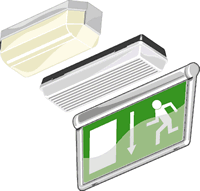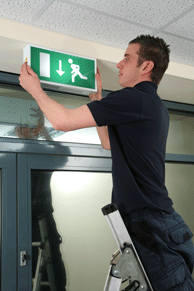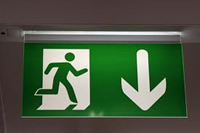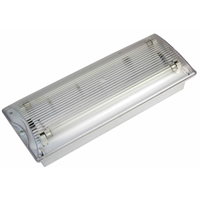
 The purpose of regular testing of your emergency lighting systems is, firstly, to ensure you continue to comply with regulations but – more importantly – to you, the person charged with the responsibility, is to ensure that the emergency lighting provides two safeguards for a building and staff in the event of power failure:
The purpose of regular testing of your emergency lighting systems is, firstly, to ensure you continue to comply with regulations but – more importantly – to you, the person charged with the responsibility, is to ensure that the emergency lighting provides two safeguards for a building and staff in the event of power failure:
First, safe and prompt access to emergency exits (egress), and second, to provide lighting of sufficient levels, and for a sufficiently long duration, to permit safe and orderly shutdown of processes that might become hazardous if simply abandoned.
Remember that failure to do so could result in prosecution in the event of an accident caused by non-compliance.
What do the regulations say?
Regulations on testing are covered by BS 5266, which details the requirements for emergency lighting.
Those requirements state that emergency lighting systems should be periodically tested and inspected to ensure that all luminaries operate correctly in power loss situations.
Who can test the emergency lighting system?
Well there are a number of checks that, if you wish, you can undertake yourself. Firstly it is recommended that the daily and monthly checks can be completed by the designated person with responsibility within the building.
Daily Check
The daily check involves completing a visual check of the emergency light indicators and the light fitting itself, i.e. are the little red LED lights on on the unit meaning power is getting to the emergency light and are the fittings suitable for their purpose and not damaged. Should either of these not be satisfactory they should be attended to immediately and be recorded in a site log
Monthly Check
The monthly check should be for visible signs of damage to fittings and a quick operational test that is to say the light be disconnected from the power source. If the device does not light, or the lamps are dim, or if it fails to light at full brilliance for 30 seconds, the unit should be serviced, repaired, or replaced with any issues once again being recorded in a site log.
Annual Check
 The annual test requires that the power actually be interrupted to the emergency lighting unit, by unplugging it, throwing a circuit breaker, or other safe means, so no line power reaches it. The unit must provide light of normal brilliance for a full 3 hours, or it should be serviced or replaced. The recommendations are that these tests be done while the building is empty and that the building remain vacated for a further 24 hours afterwards. This is because after a “soak” test such as this it would take 24 hours for the batteris in the lights to fully recharge and should a fire or some such emergency take place in the mean time then there would not be enough power in the batteries to facilitate the full 3 hours
The annual test requires that the power actually be interrupted to the emergency lighting unit, by unplugging it, throwing a circuit breaker, or other safe means, so no line power reaches it. The unit must provide light of normal brilliance for a full 3 hours, or it should be serviced or replaced. The recommendations are that these tests be done while the building is empty and that the building remain vacated for a further 24 hours afterwards. This is because after a “soak” test such as this it would take 24 hours for the batteris in the lights to fully recharge and should a fire or some such emergency take place in the mean time then there would not be enough power in the batteries to facilitate the full 3 hours
Who should complete the annual test and inspection?
In using a specialist company with competent  fully trained staff to undertake your annual check you are insuring that your installation is up to date and continues to comply with current legislation.
fully trained staff to undertake your annual check you are insuring that your installation is up to date and continues to comply with current legislation.
Once we have completed the annual test and inspection we provide a full register of all emergency lights on site along with test results, a log book detailing tests completed to date and providing recording facilities and advice on monthly testing.
The log book should record the date of each inspections  and test, date and details of any defects, action taken and detail any changes made to the installation.
and test, date and details of any defects, action taken and detail any changes made to the installation.
As Emergency Lighting specialists, we have considerable expertise in the testing and inspection of these systems. From schools and colleges to commercial offices and retail premises, we provide organisations of all types with an ongoing programme of testing and certification, along with remedial works if required.
We employ reliable professionals who are trained to deal with all aspects of electrical faults. AA Electrical Services is a reputable installation, repair and maintenance service company covering the South East area. Our team of electricians provides you with maintenance of your electrical installation and appliances as well as a fast and reliable breakdown service. Recognising current British standards, our electrical engineers are NICEIC registered, Part P accredited and qualified to 17th edition standard, as certified by the Institute of Electrical Engineers (IEE). This enables us to offer the highest levels of professional service to you.